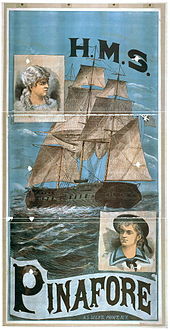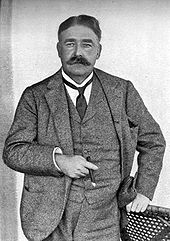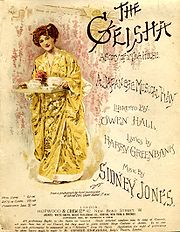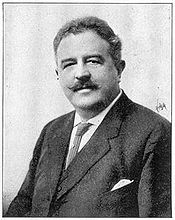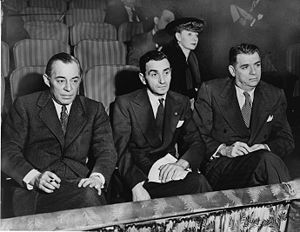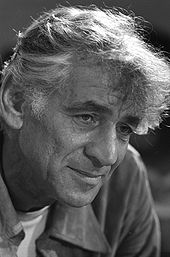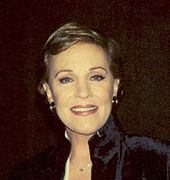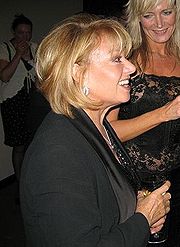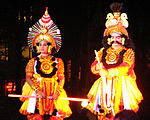- Musical theatre
-
Musical theatre is a form of theatre combining songs, spoken dialogue, acting, and dance. The emotional content of the piece – humor, pathos, love, anger – as well as the story itself, is communicated through the words, music, movement and technical aspects of the entertainment as an integrated whole. Although musical theatre overlaps with other theatrical forms such as opera, it may be distinguished by the equal importance given to the music as compared with the dialogue, movement and other elements of the works. Since the early 20th century, musical theatre stage works have generally been called, simply, "musicals".
Musicals are performed all around the world. They may be presented in large venues, such as big budget West End and Broadway theatre productions in London and New York City, or in smaller fringe theatre, Off-Broadway or regional theatre productions, on tour, or by amateur groups in schools, theatres and other performance spaces. In addition to Britain and North America, there are vibrant musical theatre scenes in many countries in Europe, Latin America, Australasia and Asia.
Although music has been a part of dramatic presentations since ancient times, modern musical theatre emerged during the 19th century, culminating with the works of Gilbert and Sullivan in Britain and those of Harrigan and Hart in America, followed by the numerous Edwardian musical comedies and the works of American creators like George M. Cohan. Early in the 20th century, the Princess Theatre musicals and other smart shows like Of Thee I Sing were artistic steps forward beyond revues and other frothy entertainments and led to such groundbreaking works as Show Boat and Oklahoma!. Some of the most famous and iconic musicals through the decades that followed include West Side Story, The Fantasticks, Hair, A Chorus Line, Les Misérables, The Phantom of the Opera, Rent, The Producers and Wicked.
Contents
- 1 Definitions
- 2 History
- 3 See also
- 4 Notes
- 5 References
- 6 Further reading
- 7 External links
Definitions
Book musicals
Since the 20th century, "book musical" has been defined as a musical play where the songs and dances are fully integrated into a well-made story, with serious dramatic goals, that is able to evoke genuine emotions other than laughter.[2][3] The three main components of a book musical are the music, the lyrics and the book. The book of a musical refers to the story, character development, and dramatic structure, including the spoken dialogue. Book can also refer to the dialogue and lyrics together, which are sometimes referred to as the libretto (Italian for “little book”). The music and lyrics together form the score of the musical. The interpretation of the musical by the creative team of each production heavily influences the way in which the musical is presented. That team includes a director, a musical director, usually a choreographer and sometimes an orchestrator. A musical's production is also creatively characterized by technical aspects, such as set design, costumes, stage properties (props), lighting and sound, which generally change from the original production to succeeding productions. Some famous production elements, however, may be retained from the original production; for example, Bob Fosse's choreography in Chicago.
There is no fixed length for a musical. It can range from a short one-act entertainment to several acts and several hours in length (or even a multi-evening presentation); however, most musicals range from one and a half hours to three hours. Musicals are usually presented in two acts, with one short intermission. The first act is frequently longer than the second act. It generally introduces nearly all of the characters and most of the music, and often ends with the introduction of a dramatic conflict or plot complication. The second act may introduce a few new songs but usually contains reprises of important musical themes and resolves the conflict or complication. A book musical is usually built around four to six main theme tunes that are reprised later in the show, although it sometimes consists of a series of songs not directly musically related. Spoken dialogue is generally interspersed between musical numbers, although "sung dialogue" or recitative may be used, especially in so-called "sung-through" musicals such as Jesus Christ Superstar, Les Misérables, and Evita. Several shorter musicals on Broadway and in the West End have been presented in one act in recent decades.
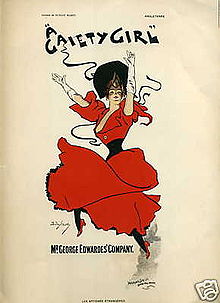 A Gaiety Girl (1893) was one of the first hit musicals.
A Gaiety Girl (1893) was one of the first hit musicals.
A book musical's moments of greatest dramatic intensity are often performed in song. Proverbially, "when the emotion becomes too strong for speech you sing; when it becomes too strong for song, you dance." In a book musical, a song is ideally crafted to suit the character (or characters) and their situation within the story; although there have been times in the history of the musical (e.g. from the 1890s to the 1920s) when this integration between music and story has been tenuous. As New York Times critic Ben Brantley described the ideal of song in theatre in reviewing the 2008 revival of Gypsy, "There is no separation at all between song and character, which is what happens in those uncommon moments when musicals reach upward to achieve their ideal reasons to be."[4] Typically, many fewer words are sung in a five-minute song than are spoken in a five-minute block of dialogue. Therefore there is less time to develop drama in a musical than in a straight play of equivalent length, since a musical usually devotes more time to music than to dialogue. Within the compressed nature of the musical, the writers must develop the characters and the plot.
The material in a musical may be original, or it may be adapted from novels (Wicked and Man of La Mancha), plays (Hello, Dolly!), classic legends (Camelot), historical events (Evita) or films (The Producers and Hairspray). On the other hand, many successful musical theatre works have been adapted for musical films, such as The Sound of Music, West Side Story, My Fair Lady, and Chicago.
Distinctions and overlap with opera; other forms
Musical theatre is closely related to another theatrical performance art, opera. These forms are usually distinguished by weighing a number of factors. Musicals generally have a greater focus on spoken dialogue (though some musicals are entirely accompanied and sung through; and on the other hand, some operas, such as Die Zauberflöte, and most operettas, have some unaccompanied dialogue); on dancing (particularly by the principal performers as well as the chorus); on the use of various genres of popular music (or at least popular singing styles); and on the avoidance of certain operatic conventions. In particular, a musical is almost always performed in the language of its audience. Musicals produced in London or New York, for instance, are invariably sung in English, even if they were originally written in another language (Les Misérables, originally written in French, is a good example). While an opera singer is primarily a singer and only secondarily an actor (and rarely needs to dance), a musical theatre performer is often an actor first and then a singer and dancer. Someone who is equally accomplished at all three is referred to as a "triple threat". Composers of music for musicals often consider the vocal demands of roles with musical theatre performers in mind. Today, theatres staging musicals generally use amplification of the actors' singing voices in a way that would generally be disapproved of in an operatic context.
Some works (e.g. by George Gershwin, Leonard Bernstein and Stephen Sondheim) have received both "musical theatre" and "operatic" productions.[5][6] Similarly, some older operettas or light operas (such as The Pirates of Penzance by Gilbert and Sullivan) have had modern productions or adaptations that treat them as musicals. For some works, production styles are almost as important as the work's musical or dramatic content in defining into which art form the piece falls.[7] Sondheim said: "I really think that when something plays Broadway it's a musical, and when it plays in an opera house it's opera. That's it. It's the terrain, the countryside, the expectations of the audience that make it one thing or another."[8] This article primarily concerns musical theatre works that are "non-operatic", but overlap remains between lighter operatic forms and the more musically complex or ambitious musicals. In practice, it is often difficult to distinguish among the various kinds of musical theatre, including "musical play", "musical comedy", "operetta" and "light opera".
India produces numerous musical films, referred to as "Bollywood" musicals, and in Japan a series of musicals based on popular Anime and Manga comics has developed. Other current musical forms include the revue. Another recent genre of musicals, called "jukebox musicals" (for instance, Mamma Mia!), weaves songs written by (or introduced by) a popular artist, group or genre into a story, sometimes based on the life or career of the person/group in question. Shorter "junior" versions of many musicals are available for schools and youth groups, and very short works created or adapted for performance by children are sometimes called minimusicals.[9][10]
History
Antiquity to Middle Ages
Musical theatre in Europe dates back to the theatre of the ancient Greeks, who included music and dance in their stage comedies and tragedies in the 5th century BCE.[11] The dramatists Aeschylus and Sophocles composed their own music to accompany their plays and choreographed the dances of the chorus. The 3rd-century BCE Roman comedies of Plautus included song and dance routines performed with orchestrations. The Romans introduced technical innovations. For example, to make the dance steps more audible in large open air theatres, Roman actors attached metal chips called "sabilla" to their stage footwear – the first tap shoes.[12] By the Middle Ages, theatre in Europe consisted mostly of travelling minstrels and small performing troupes of performers singing and offering slapstick comedy.[13] In the 12th and 13th centuries, religious dramas, such as The Play of Herod and The Play of Daniel taught the liturgy, set to church chants. Later "Mystery plays" were created that told a biblical story in a sequence of entertaining parts. Several pageant wagons (stages on wheels) would move about the city, and a group of actors would tell their part of the story. Once finished, the group would move on with their wagon, and the next group would arrive to tell its part of the story. These plays developed into an autonomous form of musical theatre, with poetic forms sometimes alternating with the prose dialogues and liturgical chants. The poetry was provided with modified or completely new melodies.[14]
Musical theatre in India also began in antiquity, with highly stylized ancient Sanskrit drama focused on spectacle, where the dramatic experience was created by combining Classical Indian music, Classical Indian dance and mime. Natya Shastra was a form of Sanskrit dance-drama. As Sanskrit theatre declined, around the 10th century, Indian folk theatre became popular. The theatre of the Parsi people "blended realism and fantasy, music and dance, narrative and spectacle, earthy dialogue and ingenuity of stage presentation, integrating them into a dramatic discourse of melodrama."[15] These theatrical forms have had an influence on modern Indian cinema, including the Bollywood films.[15]
Renaissance to the 1700s
The European Renaissance saw older forms evolve into commedia dell'arte, an Italian tradition where raucous clowns improvised their way through familiar stories, and from there, opera buffa.
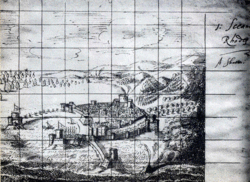 A view of Rhodes, designed by John Webb, to be painted on a backshutter for the first performance of The Siege of Rhodes, 1856
A view of Rhodes, designed by John Webb, to be painted on a backshutter for the first performance of The Siege of Rhodes, 1856
In England, Elizabethan and Jacobean plays frequently included music, with performances on organs, lutes, viols and pipes for up to an hour before and during the performance.[16] Plays, perhaps particularly the heavier histories and tragedies, were frequently broken up with a short musical play, perhaps derived from the Italian intermezzo, with music, jokes and dancing, or were followed by an afterpiece known as a jigg, often consisting of scandalous or libellous dialogue set to popular tunes (anticipating the Ballad Opera).[17] Court masques developed during the Tudor period. Masques were elaborate performances involving music, dancing, singing and acting, often with expensive costumes and a complex stage design, sometimes by a renowned architect such as Inigo Jones, presented a deferential allegory flattering to a noble or royal patron.[18] Ben Jonson wrote many masques, often collaborating with Jones. Shakespeare included masque-like sections in many of his plays.[19]
The musical sections of masques developed into sung plays that are recognizable as English operas, the first usually being thought of as William Davenant's The Siege of Rhodes (1656), originally given in a private performance.[20] In France, meanwhile, Molière turned several of his farcical comedies into musical entertainments with songs (music provided by Jean Baptiste Lully) and dance in the late 17th century. His Psyche was the model for an English opera by Thomas Shadwell, The Miser produced in 1672.[21] Davenant produced The Tempest in 1667, which was the first Shakespeare plot set to music, and which was then adapted by Shadwell into an opera in 1674 (composed by Matthew Locke and others).[21] About 1683, John Blow composed Venus and Adonis, often considered the first true English-language opera.[22] Blow was followed by Henry Purcell and a brief period of English opera. After the death of Charles II in 1685, English opera began to fall out of fashion.[20]
By the 18th century, two forms of musical theatre were popular in Britain: ballad operas, like John Gay's The Beggar's Opera (1728), that included lyrics written to the tunes of popular songs of the day (often spoofing opera), and comic operas, with original scores and mostly romantic plot lines, like Michael Balfe's The Bohemian Girl (1845). Meanwhile, on the continent, Singspiel, Comédie en vaudeville, Opéra comique and other forms of light musical entertainment were emerging. Other musical theatre forms developed by the 19th century, such as music hall, melodrama, burlesque and vaudeville. Melodramas and burlettas, in particular, were popularized partly because most London theatres were licensed only as music halls and not allowed to present plays without music. In any event, what a piece was called did not necessarily define what it was. The Broadway extravaganza The Magic Deer (1852) advertised itself as "A Serio Comico Tragico Operatical Historical Extravaganzical Burletical Tale of Enchantment."[13]
The first recorded long running play of any kind was The Beggar's Opera, which ran for 62 successive performances in 1728. It would take almost a century before the first play broke 100 performances, with Tom and Jerry, based on the book Life in London (1821), and the record soon reached 150 in the late 1820s.[23] Colonial America did not have a significant theatre presence until 1752, when London entrepreneur William Hallam sent a company of twelve actors to the colonies with his brother Lewis as their manager.[24] They established a theatre in Williamsburg, Virginia and opened with The Merchant of Venice and The Anatomist. The company moved to New York in the summer of 1753, performing ballad-operas such as The Beggar’s Opera and ballad-farces like Damon and Phillida.[24] By the 1840s, P.T. Barnum was operating an entertainment complex in lower Manhattan.[25] Theatre in New York moved from downtown gradually to midtown from around 1850, seeking less expensive real estate prices, and did not arrive in the Times Square area until the 1920s and 1930s. Broadway's first "long-run" musical was a 50 performance hit called The Elves in 1857. New York runs continued to lag far behind those in London, but Laura Keene's "musical burletta" Seven Sisters (1860) shattered previous New York records with a run of 253 performances.[26]
Development of musical comedy
1850s to 1880s
Around 1850, the French composer Hervé was experimenting with a form of comic musical theatre that came to be called opérette.[27] The best known composers of operetta were Jacques Offenbach from the 1850s to the 1870s and Johann Strauss II in the 1870s and 1880s. Offenbach's fertile melodies, combined with his librettists' witty satire, formed a model for the musical theatre that followed. In 1957, Mark Lubbock traced the development of musical theatre from Offenbach to Gilbert and Sullivan and eventually to Irving Berlin and Rodgers and Hammerstein, writing: "Offenbach is undoubtedly the most significant figure in the history of the 'musical'.[28] In the mid-19th century in England, musical theatre consisted of mostly of music hall, adaptations of the French operettas (played in bad, risqué translations) and musical burlesques (the culmination of which were seen at the Gaiety Theatre beginning in 1868). In reaction to these, a few family-friendly entertainments were created, such as the German Reed Entertainments.[29]
In America, the first original theatre piece in English that conforms to the modern conception of a musical, adding dance and original music that helped to tell the story, is generally considered to be The Black Crook, which premiered in New York on September 12, 1866. The production was a staggering five-and-a-half hours long, but despite its length, it ran for a record-breaking 474 performances. The same year, The Black Domino/Between You, Me and the Post was the first show to call itself a "musical comedy." Comedians Edward Harrigan and Tony Hart produced and starred in musicals on Broadway between 1878 (The Mulligan Guard Picnic) and 1885, with book and lyrics by Harrigan and music by his father-in-law David Braham. These musical comedies featured characters and situations taken from the everyday life of New York's lower classes and represented a significant step from burletta, minstrel shows, music hall and burlesque, towards a more legitimate theatrical form. They starred high quality singers (Lillian Russell, Vivienne Segal, and Fay Templeton) instead of the ladies of questionable repute who had starred in earlier musical forms.
The length of runs in the theatre changed rapidly around the same time that the modern musical emerged. As transportation improved, poverty in London and New York diminished, and street lighting made for safer travel at night, the number of potential patrons for the growing number of theatres increased enormously. Plays could run longer and still draw in the audiences, leading to better profits and improved production values. The first play to achieve 500 consecutive performances was the London (non-musical) comedy Our Boys, opening in 1875, which set an astonishing new record of 1,362 performances.[23] This run was not equaled on the musical stage until World War I, but musical theatre soon broke the 500 performance mark in London, most notably by the series of more than a dozen long-running Gilbert and Sullivan family-friendly comic opera hits, including H.M.S. Pinafore in 1878 and The Mikado in 1885. These were sensations on both sides of the Atlantic and, along with the other changes in the theatre, raised the standard for what was considered a successful run. Only a few 19th century musical pieces exceeded the run of the Mikado: The Chimes of Normandy (Les Cloches de Corneville) ran for 705 performances in 1878 in London, and Alfred Cellier and B. C. Stephenson's 1886 hit, Dorothy (a show midway between comic opera and musical comedy) set a new record with 931 performances.
Gilbert and Sullivan's influence on later musical theatre was profound, creating examples of how to "integrate" musicals so that the lyrics and dialogue were designed to advance a coherent story.[30][31] Their works were admired by and copied by early authors and composers of musicals such as Ivan Caryll, Lionel Monckton, P. G. Wodehouse,[32][33] and Victor Herbert, and later Jerome Kern, Ira Gershwin, Yip Harburg,[34] Irving Berlin, Ivor Novello, Oscar Hammerstein II and Andrew Lloyd Webber.[35] Other British composers of the 1870s and 1880s included Edward Solomon and F. Osmond Carr. The most popular British shows, beginning with the Savoy operas, also enjoyed profitable New York productions and tours of Britain, America, Europe, Australasia and South Africa. These shows were fare for "respectable" audiences, a marked contrast from the risqué burlesques, melodramas, minstrel shows, bawdy music hall shows and French operettas that dominated the stage prior to Gilbert and Sullivan and drew a sometimes seedy crowd looking for less wholesome entertainment.[29]
1890s to the new century
Charles Hoyt's A Trip to Chinatown (1891) was Broadway's long-run champion (until Irene in 1919), running for 657 performances. Gilbert and Sullivan's comic operas were both pirated and imitated in New York by productions such as Reginald de Koven's Robin Hood (1891) and John Philip Sousa's El Capitan (1896). A Trip to Coontown (1898) was the first musical comedy entirely produced and performed by African Americans in a Broadway theatre (largely inspired by the routines of the minstrel shows), followed by the ragtime-tinged Clorindy, or the Origin of the Cakewalk (1898), and the highly successful In Dahomey (1902). Hundreds of musical comedies were staged on Broadway in the 1890s and early 20th century composed of songs written in New York's Tin Pan Alley by composers such as Gus Edwards, John Walter Bratton and George M. Cohan (Little Johnny Jones (1904)). Still, New York runs continued to be relatively short, with a few exceptions, compared with London runs, until the 1920s.[23] Tours, however, were often extensive, beginning with the original Broadway cast.[36]
Meanwhile, musicals had spread to the London stage by the Gay Nineties. George Edwardes had left the management of Richard D'Oyly Carte's Savoy Theatre. He took over the Gaiety Theatre and, at first, he improved the quality of the old burlesques. He perceived that audiences wanted a new alternative to the Savoy-style comic operas and their intellectual, political, absurdist satire. He experimented with a modern-dress, family-friendly musical theatre style, with breezy, popular songs, snappy, romantic banter, and stylish spectacle at the Gaiety, Daly's Theatre and other venues. These drew on the traditions of comic opera and also used elements of burlesque and of the Harrigan and Hart pieces. He replaced the bawdy women of burlesque with his "respectable" corps of dancing, singing Gaiety Girls to complete the musical and visual fun. The success of the first of these, In Town in 1892 and A Gaiety Girl in 1893, confirmed Edwardes on the path he was taking. These "musical comedies", as he called them, revolutionized the London stage and set the tone for the next three decades.
Edwardes' early Gaiety hits included a series of light, romantic "poor maiden loves aristocrat and wins him against all odds" shows, usually with the word "Girl" in the title, including The Shop Girl (1894) and A Runaway Girl (1898), with music by Ivan Caryll and Lionel Monckton. These shows were immediately widely copied at other London theatres (and soon in America), and the Edwardian musical comedy swept away the earlier musical forms of comic opera and operetta. At Daly's Theatre, Edwardes presented slightly more complex comedy hits. The Geisha (1896) by Sidney Jones with lyrics by Harry Greenbank and Adrian Ross and then Jones' San Toy (1899) each ran for more than two years and also found great international success, for example in Australian productions by J. C. Williamson.
The British musical comedy Florodora (1899) by Leslie Stuart and Paul Rubens made a splash on both sides of the Atlantic, as did A Chinese Honeymoon (1901), by British lyricist George Dance and American-born composer Howard Talbot, which ran for a record setting 1,074 performances in London and 376 in New York. The story concerns couples who honeymoon in China and inadvertently break the kissing laws (shades of The Mikado). The Belle of New York (1898) ran for 697 performances in London after a brief New York run, becoming the first American musical to run for over a year in London. After the turn of the 20th century, Seymour Hicks (who joined forces with American producer Charles Frohman) wrote popular shows with composer Charles Taylor and others, and Edwardes and Ross continued to churn out hits like The Toreador (1901), A Country Girl (1902), The Orchid (1903), The Girls of Gottenberg (1907) and Our Miss Gibbs (1909). Other Edwardian musical comedy hits included The Arcadians (1909) and The Quaker Girl (1910).[37]
Operetta and World War I
Virtually eliminated from the English-speaking stage by competition from the ubiquitous Edwardian musical comedies in the 1890s, operettas returned to London and Broadway in 1907 with The Merry Widow, and operettas and musicals became direct competitors for a time. In the early years of the 20th century, English-language adaptations of 19th century continental operettas, as well as operettas by a new generation of European composers, such as Franz Lehár and Oscar Straus, among others, spread throughout the English-speaking world. In America, Victor Herbert produced a string of famous operettas (The Fortune Teller (1898), Babes in Toyland (1903), Mlle. Modiste (1905), The Red Mill (1906) and Naughty Marietta (1910)), often with librettist Harry B. Smith, as well as some intimate musical plays with modern settings.
Among other British and American composers and librettists of the 1910s, the team of P. G. Wodehouse, Guy Bolton and Jerome Kern stood out. Following in the footsteps of Gilbert and Sullivan, their "Princess Theatre shows" paved the way for Kern's later work by showing that a musical could combine light, popular entertainment with continuity between its story and songs:[38]
"These shows built and polished the mold from which almost all later major musical comedies evolved. ... The characters and situations were, within the limitations of musical comedy license, believable and the humor came from the situations or the nature of the characters. Kern's exquisitely flowing melodies were employed to further the action or develop characterization. The integration of song and story is periodically announced as a breakthrough in ... musical theater. Great opera has always done this, and it is easy to demonstrate such integration in Gilbert and Sullivan or the French opera bouffe. However, early musical comedy was often guilty of inserting songs in a hit-or-miss fashion. The Princess Theatre musicals brought about a change in approach. P. G. Wodehouse, the most observant, literate, and witty lyricist of his day, and the team of Bolton, Wodehouse, and Kern had an influence which can be felt to this day.[39]The theatre-going public needed escapist entertainment during the dark times of World War I, and they flocked to the theatre. Harry Tierney and Joseph McCarthy's 1919 hit musical Irene ran for 670 performances – a Broadway record that held until 1938's Hellzapoppin. The British public supported far longer runs like that of Maid of the Mountains (1,352 performances) and especially Chu Chin Chow. Its run of 2,238 performances was more than twice as many as any previous musical, setting a record that stood for nearly forty years until Salad Days. Revues like The Bing Boys Are Here in Britain, and the reviews of Florenz Ziegfeld and his imitators in America, were also extraordinarily popular. A new generation of composers of operettas emerged in the 1920s, such as Rudolf Friml and Sigmund Romberg.[13]
The primacy of British musical theatre from the 19th century through 1920 was gradually replaced by American innovation in the 20th century. Edwardes' competitor and counterpart in the U.S. was Charles Frohman and his Theatrical Syndicate. George M. Cohan's and Herbert's musical entertainments after the turn of the century gave way to the Princess Theatre shows and a profusion of other musicals as Kern and other Tin Pan Alley composers began to bring new musical styles such as ragtime and jazz to the theatres. Ziegfeld's popular revues spawned imitators. The Shubert Brothers took control of the Broadway theatres after the war as new writers like the Gershwin brothers (George and Ira), Irving Berlin and Rodgers and Hart began to produce shows. Musical theatre writer Andrew Lamb notes, "The triumph of American works over European in the first decades of the twentieth century came about against a changing social background. The operatic and theatrical styles of nineteenth-century social structures were replaced by a musical style more aptly suited to twentieth-century society and its vernacular idiom. It was from America that the more direct style emerged, and in America that it was able to flourish in a developing society less hidebound by nineteenth-century tradition."[40]
The Roaring Twenties and the Great Depression
The motion picture mounted a challenge to the stage. At first, films were silent and presented only a limited challenge to theatre. But by the end of the 1920s, films like The Jazz Singer could be presented with synchronized sound, and critics wondered if the cinema would replace live theatre altogether. The musicals of the Roaring Twenties, borrowing from vaudeville, music hall and other light entertainments, tended to ignore plot in favor of emphasizing star actors and actresses, big dance routines, and popular songs. Throughout the first half of the 20th century, popular music was dominated by theatre writers. Many shows were revues with little plot. For instance, Florenz Ziegfeld produced annual spectacular song-and-dance revues on Broadway featuring extravagant sets and elaborate costumes, but there was little to tie the various numbers together. In London, the Aldwych Farces were similarly successful, and stars such as Ivor Novello were popular. These spectacles also raised production values, and mounting a musical generally became more expensive.
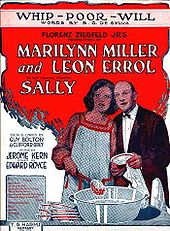 Sheet music from Sally, 1920
Sheet music from Sally, 1920
Typical of the decade were lighthearted productions like Sally; Lady Be Good; Sunny; No, No, Nanette; Oh, Kay!; and Funny Face. While the books of these shows may have been forgettable, they produced dozens of enduring popular songs ("standards") by, most notably, Jerome Kern, the Gershwin brothers, Cole Porter, Vincent Youmans, and Richard Rodgers and Lorenz Hart, among others, and featured stars such as Marilyn Miller and Fred Astaire. These musicals and standards became popular on both sides of the Atlantic ocean. Meanwhile, operettas (after being nearly absent from the English-speaking stage since World War I) from continental European composers as well as by Noël Coward in London and Sigmund Romberg and Rudolf Friml in America, regained some of their lost popularity. Neither network radio nor cinema, now with sound, killed live theatre, although it did end the popularity of live Vaudeville shows.
Progressing far beyond the comparatively frivolous musicals and sentimental operettas of the decade, Show Boat, which premiered on December 27, 1927 at the Ziegfeld Theatre in New York, represented an even more complete integration of book and score than the Princess Theatre musicals, with dramatic themes, as told through the music, dialogue, setting and movement, woven together even more seamlessly. This was accomplished by combining the lyricism of Kern with the skillful craft of Oscar Hammerstein II, who adapted Edna Ferber's novel. One historian wrote, "Here we come to a completely new genre – the musical play as distinguished from musical comedy. Now ... the play was the thing, and everything else was subservient to that play. Now ... came complete integration of song, humor and production numbers into a single and inextricable artistic entity."[41] However, Bordman argues, "Show Boat is certainly an operetta with its many arioso passages, its musical depth and seriousness, and its romantic story set, in typical operetta fashion, in the long ago and far away."[39] Nevertheless, as the Great Depression set in during the post-Broadway national tour of Show Boat, the public turned back to light, brassy, escapist entertainment, and no follow-up was produced so seriously treating serious social themes until Oklahoma! in 1943.[39]
1930s
The Great Depression affected theatre audiences on both sides of the Atlantic, as people had little money to spend on entertainment. In addition, "talkie" films at low prices presented a strong challenge to theatre of all kinds. Early musical films effectively killed off vaudeville by the early 1930s. Historian John Kenrick commented: "Top vaudeville stars filmed their acts for one-time pay-offs, inadvertently helping to speed the death of vaudeville. After all, when 'small time' theatres could offer 'big time' performers on screen at a nickel a seat, who could ask audiences to pay higher amounts for less impressive live talent?"[42] Only a few stage shows exceeded a run on Broadway or in London of 500 performances during the decade. Still, for those who could afford it, this was an exciting time in the development of musical theatre. Encouraged by the success of Show Boat, creative teams began following the "format" of that popular hit, integrating song and dance with smart books. Of Thee I Sing (1931), a political satire with music by George Gershwin and lyrics by Ira Gershwin and Morrie Ryskind, was the first musical to be awarded the Pulitzer Prize.[43] The Band Wagon (1931), starred dancing partners Fred Astaire and his sister Adele. Porter's Anything Goes (1934) confirmed Ethel Merman's position as the First Lady of musical theatre – a title she maintained for many years. As Thousands Cheer (1933) was an Irving Berlin and Moss Hart success that marked Marilyn Miller's last show and the first Broadway show to star an African-American, Ethel Waters.[44]
Gershwin's Porgy and Bess (1935) was a step closer to opera than Show Boat and the other musicals of the era, and in some respects it foreshadowed such "operatic" musicals as West Side Story and Sweeney Todd. The Cradle Will Rock (1937), with a book and score by Marc Blitzstein and directed by Orson Welles, was a highly political piece that, despite the controversy surrounding it, managed to run for 108 performances. Kurt Weill's Knickerbocker Holiday brought to the musical stage New York City's early history, using as its source writings by Washington Irving, while good-naturedly satirizing the good intentions of President Franklin D. Roosevelt.
British writers such as Noël Coward and Ivor Novello continued to deliver old fashioned, sentimental musicals, such as The Dancing Years. Similarly, Rodgers & Hart returned from Hollywood to churn out a series of lighthearted Broadway hits, including On Your Toes (1936, with Ray Bolger, the first Broadway musical to make dramatic use of classical dance), Babes In Arms (1937), I'd Rather Be Right, a political satire with George M. Cohan as President Franklin D. Roosevelt, and The Boys From Syracuse (1938), and Cole Porter wrote a similar string of hits, including Anything Goes (1934) and DuBarry Was a Lady (1939). He later would go on to write scores for such classics as Can-Can (1953) and Silk Stockings (1955). But the longest-running piece of musical theatre of the 1930s was Hellzapoppin (1938), a revue with audience participation, which played for 1,404 performances, setting a new Broadway record that was finally beaten by Oklahoma!
Despite the economic woes and the competition from film, the musical survived. In fact, the move towards political satire in Of Thee I Sing, I'd Rather Be Right and Knickerbocker Holiday, together with the musical sophistication of the Gershwin, Kern, Rodgers and Weill musicals and the fast-paced staging and naturalistic dialogue style created by director George Abbott showed that musical theatre was finally evolving beyond the gags and showgirls musicals of the Gay Nineties and Roaring Twenties and the sentimental romance of operetta.
The Golden Age (1940s to 1960s)
1940s
The 1940s would begin with more hits from Porter, Irving Berlin, Rodgers and Hart, Weill and Gershwin, some with runs over 500 performances as the economy rebounded, but artistic change was in the air.
Rodgers and Hammerstein's Oklahoma! completed the revolution begun by Show Boat, by tightly integrating all the aspects of musical theatre, with a cohesive plot, songs that furthered the action of the story, and featured dream ballets and other dances that advanced the plot and developed the characters, rather than using dance as an excuse to parade scantily clad women across the stage.[3] Rodgers and Hammerstein hired ballet choreographer Agnes de Mille, who used everyday motions to help the characters express their ideas. It defied musical conventions by raising its first act curtain not on a bevy of chorus girls, but rather on a woman churning butter, with an off-stage voice singing the opening lines of Oh, What a Beautiful Mornin' unaccompanied. It drew rave reviews, set off a box-office frenzy and received a Pulitzer Prize. Brooks Atkinson wrote in The New York Times that the show's opening number changed the history of musical theater: “After a verse like that, sung to a buoyant melody, the banalities of the old musical stage became intolerable."[45] It was the first "blockbuster" Broadway show, running a total of 2,212 performances, and was made into a hit film. It remains one of the most frequently produced of the team's projects. William A. Everett and Paul R. Laird wrote that this was a "show, that, like Show Boat, became a milestone, so that later historians writing about important moments in twentieth-century theatre would begin to identify eras according to their relationship to Oklahoma!"[46]
"After Oklahoma!, Rodgers and Hammerstein were the most important contributors to the musical-play form... The examples they set in creating vital plays, often rich with social thought, provided the necessary encouragement for other gifted writers to create musical plays of their own".[41] The two collaborators created an extraordinary collection of some of musical theatre's best loved and most enduring classics, including Carousel (1945), South Pacific (1949), The King and I (1951), and The Sound of Music (1959). Some of these musicals treat more serious subject matter than most earlier shows: the villain in Oklahoma! is a suspected murderer and psychopath with a fondness for lewd post cards; Carousel deals with spousal abuse, thievery, suicide and the afterlife; South Pacific explores miscegenation even more thoroughly than Show Boat; and the hero of The King and I dies onstage.
The show's creativity stimulated Rodgers and Hammerstein's contemporaries and ushered in the "Golden Age" of American musical theatre.[45] Americana was displayed on Broadway during the "Golden Age", as the wartime cycle of shows began to arrive. An example of this is On the Town (1944), written by Betty Comden and Adolph Green, composed by Leonard Bernstein and choreographed by Jerome Robbins. The musical is set during wartime, where a group of three sailors are on a 24 hour shore leave in New York. During their day, they each meet a wonderful woman. The women in this show have a specific power to them, as if saying, "Come here! I need a man!" The show also gives the impression of a country with an uncertain future, as the sailors also have with their women before leaving.
Oklahoma! inspired others to continue the trend. Irving Berlin used sharpshooter Annie Oakley's career as a basis for his Annie Get Your Gun (1946, 1,147 performances); Burton Lane, E. Y. Harburg, and Fred Saidy combined political satire with Irish whimsy for their fantasy Finian's Rainbow (1947, 725 performances); and Cole Porter found inspiration in William Shakespeare's Taming of the Shrew for Kiss Me, Kate (1948, 1,077 performances). The American musicals overwhelmed the old-fashioned British Coward/Novello-style shows, one of the last big successes of which was Novello's Perchance to Dream (1945, 1,021 performances).
1950s
Damon Runyon's eclectic characters were at the core of Frank Loesser's and Abe Burrows' Guys and Dolls, (1950, 1,200 performances); and the Gold Rush was the setting for Alan Jay Lerner and Frederick Loewe's Paint Your Wagon (1951). The relatively brief seven-month run of that show didn't discourage Lerner and Loewe from collaborating again, this time on My Fair Lady (1956), an adaptation of George Bernard Shaw's Pygmalion starring Rex Harrison and Julie Andrews, which at 2,717 performances held the long-run record for many years. Popular Hollywood movies were made of all of these musicals. The Boy Friend (1954) ran for 2,078 performances in London, briefly becoming the third longest-running musical in West End or Broadway history (after Chu Chin Chow and Oklahoma!), until it was demoted by Salad Days. It marked Julie Andrews' American debut.
Another record was set by The Threepenny Opera, which ran for 2,707 performances, becoming the longest-running off-Broadway musical until The Fantasticks. The production also broke ground by showing that musicals could be profitable off-Broadway in a small-scale, small orchestra format. This was confirmed in 1959 when a revival of Jerome Kern and P. G. Wodehouse's Leave It to Jane ran for more than two years. The 1959–1960 Off-Broadway season included a dozen musicals and revues including Little Mary Sunshine, The Fantasticks and Ernest in Love, a musical adaptation of Oscar Wilde's 1895 hit The Importance of Being Earnest.[47]
As in Oklahoma!, dance was an integral part of West Side Story (1957), which transported Romeo and Juliet to modern day New York City and converted the feuding Montague and Capulet families into opposing ethnic gangs, the Jets and the Sharks. The book was adapted by Arthur Laurents, with music by Leonard Bernstein and lyrics by newcomer Stephen Sondheim. It was embraced by the critics but failed to be a popular choice for the "blue-haired matinee ladies," who preferred the small town River City, Iowa of Meredith Willson's The Music Man to the alleys of Manhattan's Upper West Side. Apparently Tony Award voters were of a similar mind, since they favored the former over the latter. West Side Story had a respectable run of 732 performances (1,040 in the West End), while The Music Man ran nearly twice as long, with 1,375 performances. However, the film of West Side Story was extremely successful.[48]
Laurents and Sondheim teamed up again for Gypsy (1959, 702 performances), with Jule Styne providing the music for a backstage story about the most driven stage mother of all-time, stripper Gypsy Rose Lee's mother Rose. The original production ran for 702 performances, and was given four subsequent revivals, with Angela Lansbury, Tyne Daly, Bernadette Peters and Patti LuPone later tackling the role made famous by Ethel Merman.
The formula for the Golden Age musicals reflected four myths of the "American dream":
- Romance: stability and worth derives from a love relationship sanctioned and restricted by Protestant ideals of marriage;
- Hometown: a married couple should make a moral home with children away from the city in a suburb or small town.
- Woman as Homemaker:
- Pioneer: [49]
During the Golden Age, automotive companies and other large corporations began to hire Broadway talent to write corporate musicals, private shows which were only seen by their employees or customers.[50][51] The 1950s ended with Rodgers and Hammerstein's last hit, The Sound of Music, which also became another hit for Mary Martin. It ran for 1,443 performances and shared the Tony Award for Best Musical. Together with its extremely successful 1965 film version, it has become one of the most popular musicals in history.
1960s
In 1960, The Fantasticks was first produced off-Broadway. This intimate allegorical show would quietly run for over 40 years at the Sullivan Street Theatre in Greenwich Village, becoming by far the longest-running musical in history. Its authors produced other innovative works in the 1960s, such as Celebration and I Do! I Do!, the first two-character Broadway musical. The 1960s would see a number of blockbusters, like Fiddler on the Roof (1964; 3,242 performances), Hello, Dolly! (1964; 2,844 performances), Funny Girl (1964; 1,348 performances), and Man of La Mancha (1965; 2,328 performances), and some more risqué pieces like Cabaret, before ending with the emergence of the rock musical. Two men had considerable impact on musical theatre history beginning in this decade: Stephen Sondheim and Jerry Herman.
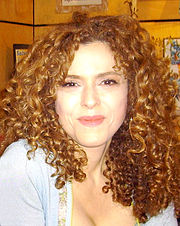 Bernadette Peters (shown in 2008) has starred in several Sondheim shows
Bernadette Peters (shown in 2008) has starred in several Sondheim shows
The first project for which Sondheim wrote both music and lyrics was A Funny Thing Happened on the Way to the Forum (1962, 964 performances), with a book based on the works of Plautus by Burt Shevelove and Larry Gelbart, and starring Zero Mostel. Sondheim moved the musical beyond its concentration on the romantic plots typical of earlier eras; his work tended to be darker, exploring the grittier sides of life both present and past. Other early Sondheim works include Anyone Can Whistle (1964, which ran only nine performances, despite having stars Lee Remick and Angela Lansbury), Company (1970), Follies (1971), and A Little Night Music (1973). Later, Sondheim found inspiration in unlikely sources—the opening of Japan to Western trade for Pacific Overtures (1976), a legendary murderous barber seeking revenge in the Industrial Age of London for Sweeney Todd (1979), the paintings of Georges Seurat for Sunday in the Park with George (1984), fairy tales for Into the Woods (1987), and a collection of presidential assassins in Assassins (1990).
While some critics have argued that some of Sondheim’s musicals lack commercial appeal, others have praised their lyrical sophistication and musical complexity, as well as the interplay of lyrics and music in his shows. Some of Sondheim's notable innovations include a show presented in reverse (Merrily We Roll Along) and the above-mentioned Anyone Can Whistle, in which the first act ends with the cast informing the audience that they are mad.
Jerry Herman played a significant role in American musical theatre, beginning with his first Broadway production, Milk and Honey (1961, 563 performances), about the founding of the state of Israel, and continuing with the smash hits Hello, Dolly! (1964, 2,844 performances), Mame (1966, 1,508 performances), and La Cage aux Folles (1983, 1,761 performances). Even his less successful shows like Dear World (1969) and Mack & Mabel (1974) have had memorable scores (Mack & Mabel was later reworked into a London hit). Writing both words and music, many of Herman's show tunes have become popular standards, including "Hello, Dolly!", "We Need a Little Christmas", "I Am What I Am", "Mame", "The Best of Times", "Before the Parade Passes By", "Put On Your Sunday Clothes", "It Only Takes a Moment", "Bosom Buddies", and "I Won't Send Roses", recorded by such artists as Louis Armstrong, Eydie Gorme, Barbra Streisand, Petula Clark and Bernadette Peters. Herman's songbook has been the subject of two popular musical revues, Jerry's Girls (Broadway, 1985), and Showtune (off-Broadway, 2003).
The musical started to diverge from the relatively narrow confines of the 1950s. Rock music would be used in several Broadway musicals, beginning with Hair, which featured not only rock music but also nudity and controversial opinions about the Vietnam War, race relations and other social issues.[52]
Social themes
After Show Boat and Porgy and Bess, and as the struggle in America and elsewhere for minorities' civil rights progressed, Hammerstein, Harold Arlen, Yip Harburg and others were emboldened to write more musicals and operas which aimed to normalize societal toleration of minorities and urged racial harmony. Early Golden Age works that focused on racial tolerance included Finian's Rainbow, South Pacific, and The King and I. Towards the end of the Golden Age, several shows tackled Jewish subjects and issues, such as Fiddler on the Roof, Milk and Honey, Blitz! and later Rags. The original concept that became West Side Story was set in the Lower East Side during Easter-Passover celebrations; the rival gangs were to be Jewish and Italian Catholic. The creative team later decided that the Polish (white) vs. Puerto Rican conflict was fresher.[53]
Tolerance as an important theme in musicals has continued in recent decades. The final expression of West Side Story left a message of racial tolerance. By the end of the 1960s, musicals became racially integrated, with black and white cast members even covering each others' roles, as they did in Hair.[54] Homosexuality has been explored in musicals, beginning with Hair, and even more overtly in La Cage aux Folles and Falsettos. The 1998 musical Parade is a sensitive exploration of both anti-Semitism and historical American racism.
More recent periods
1970s
After the success of Hair, rock musicals flourished in the 1970s, with Jesus Christ Superstar, Godspell, The Rocky Horror Show and Two Gentlemen of Verona. Some of these rock musicals began with "concept albums" and then moved to film or stage, such as Tommy. Others had no dialogue or were otherwise reminiscent of opera, with dramatic, emotional themes; these sometimes started as concept albums and were referred to as rock operas. The musical also went in other directions. Shows like Raisin, Dreamgirls, Purlie, and The Wiz brought a significant African-American influence to Broadway. More varied musical genres and styles were incorporated into musicals both on and especially off-Broadway.
1975 brought one of the great contemporary musicals to the stage, called "tremendous" by the New York Times reviewer, Clive Barnes.[55] A Chorus Line emerged from recorded group therapy-style sessions Michael Bennett conducted with Gypsies — those who sing and dance in support of the leading players —from the Broadway community. From hundreds of hours of tapes, James Kirkwood, Jr. and Nick Dante fashioned a book about an audition for a musical, incorporating into it many of the real-life stories of those who had sat in on the sessions — and some of whom eventually played variations of themselves or each other in the show. With music by Marvin Hamlisch and lyrics by Edward Kleban, A Chorus Line first opened at Joseph Papp's Public Theater in lower Manhattan. Advance word-of-mouth— that something extraordinary was about to explode — boosted box office sales, and after critics ran out of superlatives to describe what they witnessed on opening night, what initially had been planned as a limited engagement eventually moved to the Shubert Theatre on Broadway for a run of 6,137 performances, becoming the longest-running production in Broadway history up to that time. The show swept the Tony Awards and won the Pulitzer Prize, and its hit song, What I Did for Love, became an instant standard.
Broadway audiences welcomed musicals that varied from the usual style and substance. John Kander and Fred Ebb explored the rise of Nazism in Germany in Cabaret and Prohibition-era Chicago, which relied on old vaudeville techniques to tell its tale of murder and the media. Pippin, by Stephen Schwartz, was set in the days of Charlemagne. Federico Fellini's autobiographical film 8½ became Maury Yeston's Nine. At the end of the decade, Evita gave a more serious political biography than audiences were used to at musicals, and Sweeney Todd was the precursor to the darker, big budget musicals of the 1980s like Les Misérables, Miss Saigon, and The Phantom of the Opera, that depended on dramatic stories, sweeping scores and spectacular effects. But during this same period, old-fashioned values were still embraced in such hits as Annie, 42nd Street, My One and Only, and popular revivals of No, No, Nanette and Irene.
1980s and 1990s
The 1980s and 1990s saw the influence of European "mega-musicals" or "pop operas," which typically featured a pop-influenced score and had large casts and sets and were identified as much by their notable effects—a falling chandelier (in Phantom), a helicopter landing on stage (in Miss Saigon)—as they were by anything else in the production. Many were based on novels or other works of literature. The most important writers of mega-musicals include the French team of Claude-Michel Schönberg and Alain Boublil, responsible for Les Misérables, which became the longest-running international musical hit in history. The team, in collaboration with Richard Maltby, Jr., continued to produce hits, including Miss Saigon (inspired by the Puccini opera Madame Butterfly).
The British composer Andrew Lloyd Webber, saw similar mega-success with Evita, based on the life of Argentina's Eva Perón, and Cats, derived from the poems of T. S. Eliot, both of which musicals originally starred Elaine Paige. Other Lloyd Webber musical successes include Starlight Express, performed on roller skates; The Phantom of the Opera, derived from the Gaston Leroux novel, "Le Fantôme de l'Opéra"; and Sunset Boulevard (from the classic film of the same name). Several of these works ran (or are still running) for decades in both New York and London. The 1990s also saw the influence of large corporations on the production of musicals. The most important has been The Walt Disney Company, which began adapting some of its animated movie musicals for the stage, such as Beauty and the Beast and The Lion King. Disney also created original stage productions like Aida, with music by Elton John.
With the growing scale (and cost) of musicals, style was sometimes emphasized in favor of substance during the last two decades of the 20th century. At the same time, however, many writers broke from this pattern and began to create smaller scale, but critically acclaimed and financially successful musicals, such as Falsettoland, Passion, Little Shop of Horrors, Bat Boy: The Musical, and Blood Brothers. The topics vary widely, and the music ranges from rock to pop, but they often are produced off-Broadway (or for smaller London theatres) and feature smaller casts and generally less expensive productions. Some of these have been noted as imaginative and innovative.[56]
The cost of tickets to Broadway and West End musicals was escalating beyond the budget of many theatregoers, and the trend was for these musicals to be viewed by a smaller and smaller audience. Jonathan Larson's musical Rent (based on the opera La Bohème) was marketed to increase the popularity of musicals among a younger audience. It featured a young cast, and the score is heavily rock-influenced. The musical became a hit. Its young fans, many of them students, calling themselves RENTheads, lined up at the Nederlander Theatre hours early in hopes of winning the lottery for $20 front row tickets, and some have seen the show more than 50 times. Other writers who have attempted to bring a taste of modern rock music to the stage include Jason Robert Brown. Also, a majority of shows on Broadway have now followed Rent's lead by offering heavily discounted day-of-performance or standing-room tickets, although often the discounts are offered only to students.[57]
2000s
- Trends
In the new century, familiarity has been embraced by producers and investors anxious to guarantee that they recoup their considerable investments, if not show a healthy profit. Some took (usually modest-budget) chances on the new and unusual, such as Urinetown (2001), Avenue Q (2003), Caroline or Change (2004), The 25th Annual Putnam County Spelling Bee (2005), Spring Awakening (2006), In the Heights (2007) and Next to Normal (2009). But most took a safe route with revivals of familiar fare, such as Fiddler on the Roof, A Chorus Line, South Pacific, Gypsy, Hair, West Side Story and Grease, or with other proven material, such as films (The Producers, Spamalot, Hairspray, The Color Purple, Xanadu, Billy Elliot and Shrek) or well-known literature (The Scarlet Pimpernel and Wicked) hoping that the shows would have a built-in audience as a result. The reuse of film plots, especially those from Disney (such as Mary Poppins and The Little Mermaid), has been considered by some critics to be a redefinition of Broadway and West End musicals as, rather than a creative outlet, a tourist attraction.[13]
It is less likely today that a sole producer, such as David Merrick or Cameron Mackintosh, backs a production. Corporate sponsors dominate Broadway, and often alliances are formed to stage musicals which require an investment of $10 million or more. In 2002, the credits for Thoroughly Modern Millie listed ten producers, and among those names were entities composed of several individuals.[58] Typically, off-Broadway and regional theatres tend to produce smaller and therefore less expensive musicals, and development of new musicals has increasingly taken place outside of New York and London or in smaller venues. For example, Spring Awakening and Grey Gardens were developed off-Broadway before being launched on Broadway.
Several musicals returned to the spectacle format that was successful in the 1980s in such shows as Phantom of the Opera and Starlight Express, recalling extravaganzas that have been presented at times, throughout theatre history, since the ancient Romans staged mock sea battles. Examples are seen in the musical adaptations of Gone With the Wind (2008) and The Lord of the Rings (2007), the latter of which was billed as the biggest stage production in musical theatre history. The expensive productions lost money. Conversely, The Drowsy Chaperone, The 25th Annual Putnam County Spelling Bee, Xanadu and others are part of a Broadway trend to present musicals uninterrupted by an intermission, with short running time of less than two hours. The latter two, together with works like Avenue Q, also represent a trend towards presenting smaller-scale, smaller-cast musicals that are able to show a good profit in a smaller house.
- Jukebox musicals
Another trend has been to create a minimal plot to fit a collection of songs that have already been hits. Following the earlier success of Buddy - The Buddy Holly Story, these have included Movin' Out (2002, based on the tunes of Billy Joel), Jersey Boys (2006, The Four Seasons), Rock of Ages (2009, featuring classic rock of the 1980s) and many others. This style is often referred to as the "jukebox musical". Similar but more plot-driven musicals have been built around the canon of a particular pop group including Mamma Mia! (1999, based on the songs of ABBA), Our House (2002, based on the songs of Madness), and We Will Rock You (2002, based on the songs of Queen).
- Film and TV musicals
After the 1996 film of Evita, the first successful live-action movie musical in nearly two decades, Baz Luhrmann continued the revival of the movie musical with Moulin Rouge! (2001). This was followed by a series of film musicals, including Chicago in 2002; Phantom of the Opera in 2004; Dreamgirls in 2006; Hairspray, Across the Universe, Enchanted and Sweeney Todd all in 2007; Mamma Mia! in 2008; and Nine in 2009. Dr. Seuss's How the Grinch Stole Christmas! (2000) and The Cat in the Hat (2003), turned children's books into live-action movie musicals. After the immense success of Disney and other houses with animated film musicals beginning with The Little Mermaid in 1989 and running throughout the 1990s (including some more adult-themed films, like South Park: Bigger, Longer & Uncut (1999)), fewer animated movie musicals were released in the first decade of the 21st century. In Asia, India continues to produce numerous "Bollywood" film musicals, and Japan produces "Anime" and "Manga" film musicals.
Made for TV musical movies were popular in the 1990s, such as Gypsy (1993), Cinderella (1997) and Annie (1999). Several made for TV musicals in the first decade of the 21st century were adaptations of the stage version, such as South Pacific (2001), The Music Man (2003) and Once Upon A Mattress (2005), and a televised version of the stage musical Legally Blonde in 2007. Additionally, several musicals were filmed on stage and broadcast on Public Television, for example Contact in 2002 and Kiss Me, Kate and Oklahoma! in 2003. The made-for-TV musical High School Musical, and its several sequels, enjoyed particular success and were adapted for stage musicals and other media.
Some television shows have set episodes as a musical. Examples include episodes of Ally McBeal, Xena, the Buffy the Vampire Slayer episode Once More, with Feeling, That's So Raven, Daria, Oz, Scrubs (one episode was written by the creators of Avenue Q), Batman: The Brave and the Bold, episode "Mayhem of the Music Meister", and the 100th episode of That '70s Show, called That '70s Musical. Others have included scenes where characters suddenly begin singing and dancing in a musical-theatre style during an episode, such as in several episodes of The Simpsons, 30 Rock, Hannah Montana, South Park and Family Guy. The television series Cop Rock extensively used the musical format, as do the series Flight of the Conchords and Glee.
There have also been musicals made for the internet, including Dr. Horrible's Sing-Along Blog, about a low-rent super-villain played by Neil Patrick Harris. It was written during the WGA writer's strike.[59] Several reality TV shows have been used to help market musical revivals by holding a competition to cast leads. Examples of these are How Do You Solve a Problem Like Maria?, Grease: You're the One that I Want!, Any Dream Will Do and Legally Blonde - The Musical: The Search for Elle Woods.
International musicals
The U.S. and Britain were the most active sources of book musicals from the 19th century through much of the 20th century (although Europe produced various forms of popular light opera and operetta, for example Spanish Zarzuela, during that period and even earlier). However, the light musical stage in other countries has become more active in recent decades.
Musicals from other English-speaking countries (notably Australia and Canada) often do well locally, and occasionally even reach Broadway or the West End (e.g., The Boy from Oz and The Drowsy Chaperone). South Africa has an active musical theatre scene, with revues like African Footprint and Umoja and book musicals, such as Kat and the Kings and Sarafina! touring internationally. Locally, musicals like Vere, Love and Green Onions, Over the Rainbow: the all-new all-gay... extravaganza and Bangbroek Mountain and In Briefs – a queer little Musical have been produced successfully.
Successful musicals from continental Europe include shows from (among other countries) Germany (Elixier and Ludwig II), Austria (Tanz der Vampire, Elisabeth, Mozart! and Rebecca), Czech Republic (Angelika), France (Notre Dame de Paris, Les Misérables, Angélique, Marquise des Anges and Romeo & Juliette) and Spain (Hoy No Me Puedo Levantar).
Japan has recently seen the growth of an indigenous form of musical theatre, both animated and live action, mostly based on Anime and Manga, such as Kiki's Delivery Service and Tenimyu. The popular Sailor Moon metaseries has had twenty-nine Sailor Moon musicals, spanning thirteen years. Beginning in 1914, a series of popular revues have been performed by the all-female Takarazuka Revue, which currently fields five performing troupes. Elsewhere in Asia, the Indian Bollywood musical, mostly in the form of motion pictures, is tremendously successful. Hong Kong's first modern musical, produced in both Mandarin and Cantonese, is Snow.Wolf.Lake.
Other countries with an especially active musicals scene include the Netherlands, Italy, Sweden, Mexico, Brazil, Argentina, Russia, Turkey and China.[citation needed]
Relevance
The Broadway League announced that in the 2007–08 season, 12.27 million tickets were purchased for Broadway shows for a gross sale amount of almost a billion dollars.[60] The League further reported that during the 2006–07 season, approximately 65% of Broadway tickets were purchased by tourists, and that foreign tourists were 16% of attendees.[61] (These figures do not include off-Broadway and smaller venues.) The Society of London Theatre reported that 2007 set a record for attendance in London. Total attendees in the major commercial and grant-aided theatres in Central London were 13.6 million, and total ticket revenues were £469.7 million.[62] Also the international musicals scene has been particularly active in recent years. However, as Stephen Sondheim has noted:
You have two kinds of shows on Broadway – revivals and the same kind of musicals over and over again, all spectacles. You get your tickets for The Lion King a year in advance, and essentially a family... pass on to their children the idea that that's what the theater is – a spectacular musical you see once a year, a stage version of a movie. It has nothing to do with theater at all. It has to do with seeing what is familiar.... I don't think the theatre will die per se, but it's never going to be what it was.... It's a tourist attraction."[63]The success of original material like Urinetown, Avenue Q, Spelling Bee and In the Heights, as well as creative re-imaginings of film properties, including Thoroughly Modern Millie, Hairspray, Billy Elliot and The Color Purple, and plays-turned-musicals, such as Spring Awakening, prompts theatre historian John Kenrick to write: "Is the Musical dead? ...Absolutely not! Changing? Always! The musical has been changing ever since Offenbach did his first rewrite in the 1850s. And change is the clearest sign that the musical is still a living, growing genre. Will we ever return to the so-called 'golden age,' with musicals at the center of popular culture? Probably not. Public taste has undergone fundamental changes, and the commercial arts can only flow where the paying public allows."[13]
See also
- Related forms
- Cast recording
- Chinese Opera
- Classical Indian dance
- Show tunes
- Industrial musical
- Yakshagana (Indian art form)
- General
- Theatre
- List of musicals
- List of musicals by composer
- List of the longest-running Broadway shows
- Long-running musical theatre productions
- List of Tony Award and Olivier Award winning musicals
- AFI's Greatest Movie Musicals
Notes
- ^ Morley 1987, p.15.
- ^ Everett 2002, p. 137
- ^ a b Rubin, Don; [[Carlos Solórzano |Solórzano, Carlos]], eds (2000). The World Encyclopedia of Contemporary Theatre: The Americas. New York City: Routledge. p. 438. ISBN 0-415-05929-1.
- ^ Brantley, Ben (March 28, 2008). "Curtain Up! It’s Patti’s Turn at ‘Gypsy’". The New York Times. http://theater2.nytimes.com/2008/03/28/theater/reviews/28gyps.html?pagewanted=all. Retrieved May 26, 2009.
- ^ "Porgy and Bess: That old black magic", The Independent, October 27, 2006, accessed November 1, 2009
- ^ Lister, David. "The Royal Opera opens a window on Sondheim", The Independent, April 5, 2003, accessed November 1, 2009
- ^ Teachout, Terry. "Sweeney Todd", National Endowment for the Arts website, accessed November 1, 2009
- ^ White, Michael (December 15, 2003). "Something for the weekend, sir?". London: The Independent. http://www.independent.co.uk/arts-entertainment/music/features/something-for-the-weekend-sir-576691.html. Retrieved May 26, 2009.
- ^ "Mini Musicals", labyrinth.net.au, Cenarth Fox, 2001, accessed 22 January 2010
- ^ "Theatre Latte Da takes foray into mini-musical form". Star Tribune. March 30, 2002. http://nl.newsbank.com/nl-search/we/Archives?p_product=MN&p_theme=mn&p_action=search&p_maxdocs=200&p_topdoc=1&p_text_direct-0=11E2D982E50C11E0&p_field_direct-0=document_id&p_perpage=10&p_sort=YMD_date:D&s_trackval=GooglePM. Retrieved 15 January 2010. (registration required)
- ^ Thornton, Shay (2007). "A Wonderful Life" (PDF). Houston, TX: Theatre Under the Stars. p. 2. Archived from the original on November 27, 2007. http://web.archive.org/web/20071127051412/http://www.tuts.com/season07/wonderful_study.pdf. Retrieved May 26, 2009.
- ^ Flinn 1997, p. 22.
- ^ a b c d e Kenrick, John (2003). "History of Stage Musicals". http://www.musicals101.com/erastage.htm. Retrieved May 26, 2009.
- ^ Hoppin 1978, pp. 180–181.
- ^ a b Gokulsing, 2004, p. 98.
- ^ Lord 2003, p. 41
- ^ Lord 2003, p. 42
- ^ Buelow 2004, p. 26
- ^ Shakespeare 1998, p. 44.
- ^ a b Buelow 2004, p. 328
- ^ a b Carter and Butt 2005, p. 280
- ^ Parker 2001, p. 42.
- ^ a b c Gillan, Don (2007). "Longest Running Plays in London and New York". Stage Beauty. http://www.stagebeauty.net/th-frames.html?http&&&www.stagebeauty.net/th-longr.html. Retrieved May 26, 2009.
- ^ a b Wilmeth and Miller, p. 182.
- ^ Wilmeth and Miller, p. 56.
- ^ Allen 1991, p. 106.
- ^ Lubbock, Mark. "The Music of 'Musicals'". The Musical Times, Vol. 98, No. 1375 (September, 1957), pp. 483–85, Musical Times Publications Ltd., accessed 17 August 2010
- ^ Lubbock, Mark. "The Music of 'Musicals'", The Musical Times, Vol. 98, No. 1375 (September 1957), pp. 483–485 (subscription required)
- ^ a b Bond, Jessie. Introduction to The Life and Reminiscences of Jessie Bond, reprinted at The Gilbert and Sullivan Archive, accessed March 4, 2011
- ^ Jones, J. Bush. Our Musicals, Ourselves, pp. 10–11, 2003, Brandeis University Press: Lebanon, N.H. (2003) 1584653116
- ^ Bargainnier, Earl F. "W. S. Gilbert and American Musical Theatre", pp. 120–33, American Popular Music: Readings from the Popular Press by Timothy E. Scheurer, Popular Press, 1989 ISBN 0-87972-466-8
- ^ PG Wodehouse (1881–1975), guardian.co.uk, Retrieved on 21 May 2007
- ^ "List of allusions to G&S in Wodehouse". Home.lagrange.edu. http://home.lagrange.edu/arobinson/wodehousegilbert.htm. Retrieved 27 May 2009.
- ^ Meyerson, Harold and Ernest Harburg Who Put the Rainbow in the Wizard of Oz?: Yip Harburg, Lyricist, pp 15-17 (Ann Arbor: University of Michigan Press, 1993, 1st paperback edition 1995)
- ^ Bradley (2005), p. 9
- ^ Mark Evan Swartz's Oz Before the Rainbow describes the enormous train trips required of the cast of the 1903 smash hit, The Wizard of Oz, which tour ran for nine years, including on the road. See Swartz, Mark Evan. "Oz Before the Rainbow: L. Frank Baum's 'The Wonderful Wizard of Oz' on Stage and Screen to 1939". The Johns Hopkins University Press, 2000 ISBN 0801864771
- ^ See, generally, Index to The Gaiety, a British musical theatre publication with articles about Victorian and Edwardian musical theatre. Accessed February 25, 2011
- ^ Jones 2003, pp. 10–11
- ^ a b c Bordman, Gerald. "Jerome David Kern: Innovator/Traditionalist", The Musical Quarterly, 1985, Vol. 71, No. 4, pp. 468–73
- ^ Lamb, Andrew (Spring, 1986). "From Pinafore to Porter: United States-United Kingdom Interactions in Musical Theater, 1879–1929". American Music (Chicago: University of Illinois Press) 4 (British-American Musical Interactions): 47. ISSN 07344392. JSTOR 3052183.
- ^ a b Lubbock 2002.
- ^ Kenrick, John. "History of Musical Film, 1927–30: Part II". Musicals101.com, 2004, accessed May 17, 2010
- ^ Information from the Pulitzer.org website
- ^ Connema, Richard (2000). "San Francisco: As Thousands Cheer and Dear World". TalkinBroadway.Org, Inc.. http://www.talkinbroadway.com/regional/sanfran/s75.html. Retrieved May 26, 2009.
- ^ a b Gordon, John Steele. Oklahoma'!'. Retrieved June 13, 2010
- ^ Everett 2002, p. 124.
- ^ Suskin, Steven (August 10, 2003). "On the Record: Ernest In Love, Marco Polo, Puppets and Maury Yeston". Playbill, Inc.. http://web.playbill.com/news/article/81129-ON_THE_RECORD_Ernest_In_Love_Marco_Polo_Puppets_and_Maury_Yeston. Retrieved May 26, 2009.
- ^ Rich, Frank (March 12, 2000). "Conversations with Sondheim". New York Times Magazine. http://partners.nytimes.com/library/magazine/home/20000312mag-sondheim.html?scp=1&sq=conversations%20with%20sondheim&st=cse. Retrieved May 26, 2009.
- ^ World Encyclopedia, pp. 439–40
- ^ John Kander in conversation with Frank J. Oteri, April 7, 2010 NewMusicBox
- ^ Ward, Jonathan. "Recruit, Train and Motivate: The History of the Industrial Musical," March 2002, Perfect Sound Forever
- ^ Wollman, p. 12.
- ^ Laurents, Arthur (August 4, 1957). "The Growth of an Idea". New York Herald Tribune (Primate, LLC). Archived from the original on December 12, 2007. http://web.archive.org/web/20071212040338/http://www.leonardbernstein.com/studio/element.asp?FeatID=8&AssetID=18. Retrieved May 26, 2009.
- ^ Horn 1991, p. 134.
- ^ Barnes, Clive. "Theater Review": A Chorus Line". The New York Times, May 22, 1975
- ^ Shaw, Pete (2006). "A glorious musical romp – with bite!". Broadway Baby. Archived from the original on September 28, 2007. http://web.archive.org/web/20070928043409/http://www.broadwaybaby.com/edinburgh/fringe/reviews/batboy. Retrieved May 26, 2009.
- ^ Blank, Matthew (March 1, 2011). "Broadway Rush, Lottery and Standing Room Only Policies". PlayBill. http://www.playbill.com/celebritybuzz/article/82428-Broadway-Rush-Lottery-and-Standing-Room-Only-Policies. Retrieved March 1, 2011.
- ^ Thoroughly Modern Millie at the IBDB database
- ^ Roush, Matt (June 30, 2008). "Exclusive: First Look at Joss Whedon's "Dr. Horrible"". TVGuide.com. http://www.tvguide.com/roush/Exclusive-Look-Joss-9886.aspx. Retrieved May 26, 2009.
- ^ "The Broadway League Announces 2007–2008 Broadway Theatre Season Results" (Press release). Broadway League. May 28, 2008. http://www.broadwayleague.com/index.php?url_identifier=press-releases&news=the-broadway-league-announces-2007-2008-broadway-theatre-season&type=news. Retrieved May 26, 2009.
- ^ "League Releases Annual "Demographics of the Broadway Audience Report" for 06-07" (Press release). Broadway League. November 5, 2007. http://www.broadwayleague.com/index.php?url_identifier=press-releases&news=league-releases-annual-demographics-of-the-broadway-audience-report&type=news. Retrieved May 26, 2009.
- ^ "Record Attendances as Theatreland celebrates 100 Years" (PDF) (Press release). Society of London Theatre. January 18, 2008. http://www.solt.co.uk/downloads/pdfs/pressroom/SOLT_180108.pdf. Retrieved May 26, 2009.
- ^ Rich, Frank. "Conversations with Sondheim". New York Times Magazine, March 12, 2000
References
- Allen, Robert C. (c1991). Horrible prettiness: burlesque and American culture. University of North Carolina. p. 350. ISBN 978-0-8078-1960-9. http://books.google.com/?id=4IoXcZyKKJoC.
- Bradley, Ian (2005). Oh Joy! Oh Rapture! The Enduring Phenomenon of Gilbert and Sullivan. Oxford University Press. ISBN 0195167007.
- Buelow, George J. (2004). A history of baroque music. Bloomington, IN: Indiana University Press. p. 701. ISBN 978-0-253-34365-9.
- Carter, Tim; Butt, John, eds (2005). The Cambridge history of seventeenth-century music. The Cambridge History of Music. 1. Cambridge University Press. p. 591. ISBN 978-0-521-79273-8. http://histories.cambridge.org/uid=12021/extract?id=chol9780521792738_CHOL9780521792738_root.
- Everett, William A.; Laird, Paul R., eds (2002). The Cambridge companion to the musical. Cambridge companions to music. Cambridge University Press. p. 310. ISBN 978-0-521-79189-2.
- Flinn, Denny M. (c1997). Musical! : a grand tour : the rise, glory and fall of an American institution. New York: Schirmer Books. p. 556. ISBN 978-0-02-864610-7.
- Gokulsing, K. Moti; Dissanayake, Wimal (2004) [1998]. Indian popular cinema : a narrative of cultural change (Revised and updated ed.). Stoke-on-Trent: Trentham. p. 161. ISBN 978-1-85856-329-9.
- Hoppin, Richard H., ed (1978). Anthology of medieval music. Norton introduction to music history. New York, NY: Norton. p. 177. ISBN 978-0-393-09080-2.
- Horn, Barbara Lee (1991). The age of Hair: evolution and impact of Broadway’s first rock musical. New York, NY: Greenwood Press. p. 166. ISBN 978-0-313-27564-7.
- Jones, John B. (2003). Our Musicals, Ourselves. Hanover: University Press of New England. p. 411. ISBN 978-1-58465-311-0. http://books.google.com/?id=WqQH31qkYNoC.
- Lord, Suzanne (2003). Brinkman, David. ed. Music from the age of Shakespeare : a cultural history. Westport, Conn.: Greenwood Press. p. 236. ISBN 978-0-313-31713-2. http://books.google.com/?id=JLCJLjHoQ2gC.
- Lubbock, Mark (2002) [1962]. "American musical theatre: an introduction". The Complete Book of Light Opera . (1st ed.). London: Putnam. pp. 753–56. http://www.theatrehistory.com/american/musical030.html.
- Morley, Sheridan (c1987). Spread a little happiness : the first hundred years of the British musical. London: Thames and Hudson. p. 224. ISBN 978-0-500-01398-4.
- Parker, Roger, ed (2001). The Oxford illustrated history of opera. Oxford illustrated histories (illustrated ed.). Oxford University Press. p. 541. ISBN 978-0-19-285445-2. http://books.google.com/?id=ffXPHfhaWksC.
- Shakespeare, William (1998) [First published 1623]. Orgel, Stephen. ed. The tempest. The Oxford Shakespeare. Oxford University Press. p. 248. ISBN 978-0-19-283414-0.
- Wilmeth, Don B.; Miller, Tice L., eds (1996). Cambridge guide to American theatre (2nd ed.). Cambridge University Press. ISBN 978-0-521-56444-1.
- Wollman, E. L. (2006). The Theater Will Rock: a History of the Rock Musical: From Hair to Hedwig. Michigan: University of Michigan Press. ISBN 0472115766.
Further reading
- Bauch, Marc. The American Musical. Marburg, Germany: Tectum Verlag, 2003. ISBN 3-8288-8458-X
- Bauch, Marc. Themes and Topics of the American Musical after World War II. Marburg, Germany: Tectum Verlag, 2001. ISBN 3-8288-1141-8
- Bloom, Ken; Frank Vlastnik (2004-10-01). Broadway Musicals : The 101 Greatest Shows of All Time. New York, New York: Black Dog & Leventhal Publishers. ISBN 1-57912-390-2.
- Botto, Louis (2002-09-01). Robert Viagas. ed. At This Theatre. Applause Books. ISBN 1-55783-566-7.
- Ganzl, Kurt. The Encyclopedia of Musical Theatre (3 Volumes). New York: Schirmer Books, 2001.
- Kantor, Michael; Laurence Maslon (2004). Broadway: the American musical. New York, New York: Bulfinch Press. ISBN 0-8212-2905-2.
- Mordden, Ethan (1999). Beautiful Mornin': The Broadway Musical in the 1940s. New York: Oxford University Press. ISBN 0-19-512851-6.
- Stempel, Larry. Showtime: A History of the Broadway Musical Theater (W.W. Norton, 2010) 826 pages; comprehensive history since the mid-19th century.
- Traubner, Richard. Operetta: A Theatrical History. Garden City, NY: Doubleday & Company, 1983
External links
- Internet Broadway Database – Cast and production lists, song lists and award lists
- Guidetomusicaltheatre.com – synopses, cast lists, song lists, etc.
- Musicals at the Yahoo! Directory
- Castalbumdb – Musical Cast Album Database
- Early musical theatre site with links to midi files and other information
- Playbill.com
- Aussietheatre.com Australia's leading musical theatre website
- "TIME Magazine" collection of Broadway's evolution
- "A History of Musicals". Theatre & Performance. Victoria and Albert Museum. http://www.vam.ac.uk/collections/theatre_performance/features/history_of_musicals/index.html. Retrieved 2011-03-24.
Categories:- Musical theatre
- Broadway theatre
- Off-Broadway
- History of theatre
- Theatrical genres
Wikimedia Foundation. 2010.



